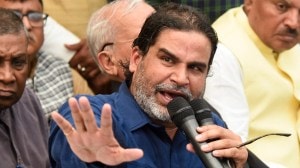Dark clouds loom over India growth story
After a series of forgettable events,the street now pins hopes on quarterly results,Government's fiscal consolidation plan,bold policy actions and next RBI policy
Has the India growth story fizzled out? The question everyone asking in 2012 was unthinkable just 18 months back. One thing common on each and every economic conclave whether on national or international platform,pertaining to India,revolved around Indias growth story. Economists,both at home and abroad,are on record saying that emerging markets will lead the next wave of global growth and India along with China will be the growth engine for the world. There was also a strong suggestion by a section of experts that India is decoupled from the rest of the world and global financial crisis will not have much impact on it.
Nothing best mirrors the economy of a nation than its equity market. Everyone took India growth story too seriously and burnt their fingers in the equity markets, said Jagannadhan Thunu-guntla of SMC Global. After the 2008 US subprime crisis which led to a severe global slowdown,benchmark BSE Sensex crashed from 21,000 to 8,500 in a matter of few months. The dream growth rates of 89 per cent made India one of the most attractive investment destination. This reflected in the inflows from foreign institutional investors (FII) in 2009 which broke all previous records. FII stayed net buyers of equities to the tune of Rs 83,423.9 crore in 2009 the year when Indian equity markets gave 80 per cent returns. It rode on the back of India growth story even in the year 2010. The year saw it breaking the highest ever FII inflow of 2009 and ended with net equity investments by FIIs at Rs 1,33,266 crore.
The party,however,was short lived. Economic realities finally prevailed over every speculation and year 2011 saw the reversal of fortunes for the equity investors as FIIs pulled out money from Indian markets. Early signs of recovery in the US also saw money moving from emerging markets to the developed world.
India,already battling high inflation and consequent high interest rates,was badly caught in several critical challenges. The Governments fiscal deficit,weak global economy,shocks in crude oil prices,domestic political instability resulting in a complete halt in economic reforms were the hallmarks of the year and that reflected in the equity markets. In a complete contrast to 2009 and 2010,the year saw an FII outflow of Rs 2,812 crore.
Some like Goldman Sachs are,however,bullish. In its latest report,the US-based banking conglomerate says domestic growth will pick up,while stock valuations remain “relatively attractive.” It set a March 2013 target of 6,100 for the Nifty index and said Indian growth will pick up to 7.2 per cent this year and 7.8 per cent in 2013,from 6.9 per cent last year,while slowing core inflation would allow Reserve Bank of India to cut the repo rate by 150 basis points during fiscal 2013.
It said growth will indeed pick up in India over the next one to two quarters and that the equity market will start to reflect these prospects in the coming months. However,the major three events in the early part of 2012 are over now state elections,mid-quarter policy review by the RBI and the Union Budget. All three proved to be a non-event for the equity markets and failed to enthuse the investors.
There is nothing great left for investors as the share prices can fluctuate 50 to 80 per cent on either side in the span of just on settlement, said Kishor P Ostwal,CMD,CNI Research which aptly sums up the current situation in the Indian equity markets. Its non-performance can be mainly attributed to key sectors in distress like power,aviation,textiles and infrastructure.
In the short term,expectations on the interest rate cut and quarterly results of companies would decide the direction of the market. April will be an important month for those tracking equity markets closely. The annual and fourth quarter report to be announced by the companies and the RBI’s annual monetary policy will hold the key going forward. “Corporate earnings are likely to go up and we should see positive results in April. Sectors like IT,banking and pharma will do well,” says Vinesh Menon of Bajaj Capital. Experts believe fiscal consolidation measures and monetary easing could be the two big triggers for a secular uptrend.The RBI should cut the interest rates only after the fuel price hike which will drive the equity markets in a much secular way. The economy first needs fiscal consolidation measures and then monetary easing, says Sankaran Naren,chief investment officer,ICICI Prudential Mutual Fund. Big ticket refor-ms are required in power which may not go through due to elections ahead in 2014 and lack of will to take action. Coal again is a major headache. Textiles are facing steep competition from China. Infrastructure is always on wish list of government but the empty coffers have nothing big in store at the moment, Ostwal says.
The companies in the sectors in distress are under tremendous pressure making investors feel stuck. Is there money to be made on the battered stocks? This is the question on everyone’s mind after watching the stocks tumble sharply over the last few months. Globally,distressed sectors are offered to people who are specialists in the area of equity investing. Retail investors should not touch such companies, said Naren.
Most fund managers and broking houses are avoiding making any guesses on the kind of returns one can make in the next 12-18 months. “One should use dip to accumulate stocks of companies having ethical managements and strong balance sheets with a medium to long term view,” says Dipen Shah of Kotak Securities.
Some confidence provided by the key economic reforms like FDI in aviation,retail and pension along with banking reforms can bring back the investors in the Indian equity markets which can take it to previous highs. However,unless India sees some bold policy actions,and that too on an absolute urgent basis,it will not take it long to undo the gains made in the last few years.
ritukant.ojhaexpressindia.com



- 01
- 02
- 03
- 04
- 05




























